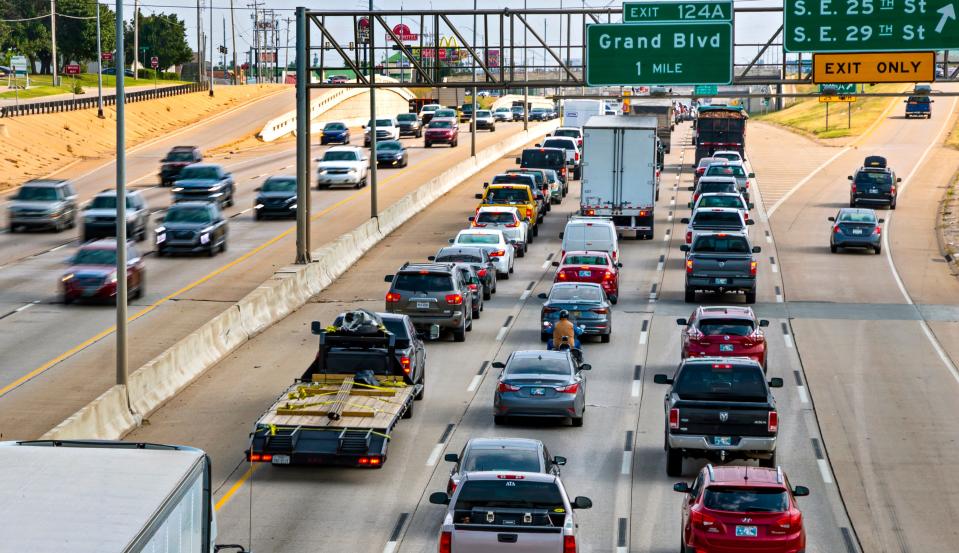Solar eclipse warnings piling up: Should Oklahomans be worried on April 8, 2024?
Excitement is growing for those in or near areas that will see a total solar eclipse in early April — but safety concerns are also on the rise.
The April 8, 2024 solar eclipse will pass over states from Texas to Maine, including southeast Oklahoma.
A number of safety warnings have come down from state governments, law enforcement and industry experts for what is happening in the sky and on the ground — especially in the path of totality, where the moon will completely block out the sun and plunge the Earth into darkness.
Here's what we know about what Oklahomans should plan for, and what safety warnings to know about.
More: What time is the solar eclipse 2024? How long will it last in Oklahoma?
Increased visitors means increased traffic, emergency response time

Oklahoma is expected to receive an influx of visitors anywhere from 17,000 to 66,000, and the swarm of tourists could cause overwhelming traffic, delays in supply chains and decreased cellular service quality, according to the Oklahoma Department of Emergency Management.
As thousands of visitors trek to southeastern Oklahoma to experience the total solar eclipse, the area's road systems, which include US-70, US-259 and State Highway 3, could get backed up.
According to the state, residents and visitors to the area should expect:
Increased tourists and visitors
Increased traffic
Maximum capacity in hotels, cabins and campgrounds
Decreased quality of cellular service
Delays in supply chains and deliveries
Increased emergency response times
Safety tips for Oklahomans during the eclipse
To prepare for the delays and increased traffic, the state government offered tips for Oklahomans:
Schedule errands and appointments two to three days before the eclipse.
Fill up gas tanks.
Buy and stock up on groceries.
Have several forms of communication, not only cellular.
Be sure to check the weather.
If traveling to the area, arrive early; stay put; and leave late.
Safety tips for those traveling to and from southeastern Oklahoma include:
Don't stop along roadways or the shoulders of roadways.
Exit the roadway to view or photograph the event.
Don't take photographs while driving.
Turn your headlights on.
Watch out for pedestrians.
Don't pick up hitchhikers.
Prepare for congestion on the day before, day of, and day after the eclipse.
Experts warn about dangers of fake eclipse glasses
"Counterfeit and fake eclipse glasses are polluting the marketplace," the American Astronomical Society announced in a statement in late March.
Using fake eclipse glasses — or no glasses at all — to look at the eclipse is dangerous to your eyes: Overexposure to sunlight "can cause severe eye injury, ranging from temporarily impaired vision to permanent blindness," the AAS said. They recommend buying from a vetted vendor and testing the glasses before the eclipse.
Here's how to tell if your glasses are legit.
It's also worth noting that you may be able to score a free pair of eclipse glasses.
Eclipse could lead to bad traffic and deadly traffic accidents
Traffic is predicted to be bad and potentially deadly — especially after the eclipse ends. Millions of people will crowd into the narrow path of totality, then most will attempt to leave all at once as soon as the eclipse is over.
In Oklahoma, roads could be especially packed at the center of the eclipse's path as Oklahomans and those from neighboring states who want the best view crowd into small towns like Broken Bow and Idabel, or one of southeast Oklahoma's many unincorporated communities.
According to a statement from the New York State Police, during the 2017 solar eclipse, some regions experienced a 100% increase in population in the days leading up to and during the eclipse.
When a total solar eclipse passed over the U.S. in 2017, reports say some traffic jams didn't fully clear for more than 12 hours in some areas.
Even worse, a recent study reported that the 2017 eclipse "was associated with increased risks of a fatal traffic crash" – potentially as much as a 31% increase, the study said.
Air travel also impacted

The Federal Aviation Administration (FAA) is offering guidance to commercial planes and private aircraft ahead of the eclipse.
"Due to the high volume of traffic along the eclipse path, (airport) arrivals can expect lengthy delays during peak traffic periods," the FAA said.
Airports in Texas, Vermont, Maine, Canada, New Hampshire, Indiana, Ohio, Pennsylvania, Oklahoma, Arkansas, Illinois, Kentucky and Missouri will be primarily affected by the eclipse, the FAA said.
"The purpose of this notice is to inform airmen of the possible impacts to air traffic and airports along the eclipse path during the period April 7, 2024, (6 a.m. EST) through April 10, 2024, (midnight EST)," the FAA said.
More: What travelers should know about FAA advisory on total solar eclipse before April 8
Contributing: Jonathan Limehouse and Kayla Jimenez, USA TODAY
This article originally appeared on Oklahoman: Solar eclipse warnings say traffic, eyesight at risk on April 8

